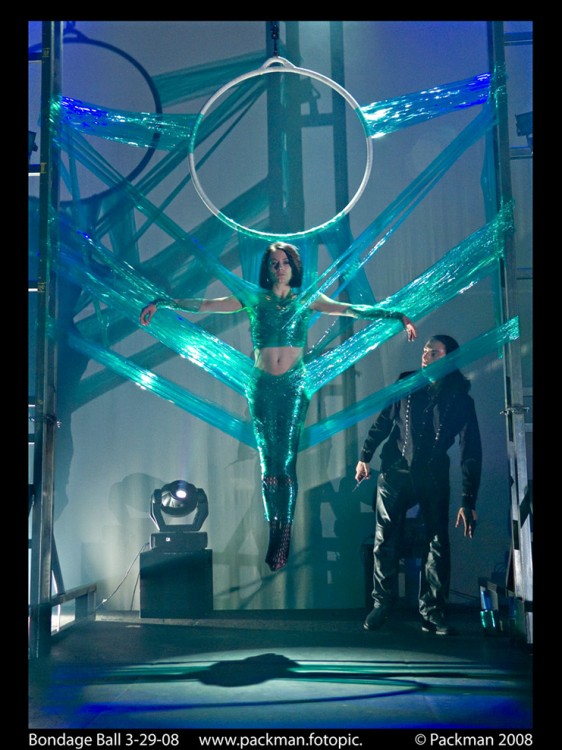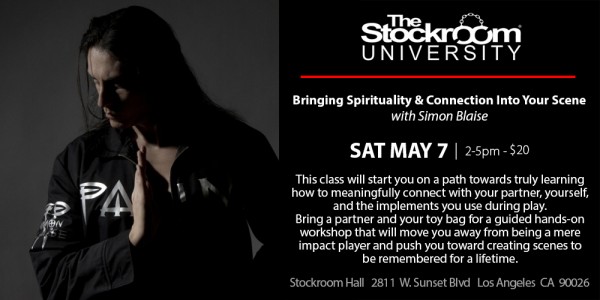
Simon Blaise is an internationally-acclaimed BDSM educator and presenter who is also a vocal activist. As an attorney, Simon has been a pro bono advocate for members of BDSM communities who face legal problems because they love kink. In his own life, he’s challenged the gender norms of kink by being one of the first doms to come out as a transgender person who identifies as both male and female. On May 7, Simon will be giving a presentation at Stockroom University on how to make your kinky scenes more than just spanking or flogging sessions and become instead something that builds a profound spiritual and emotional connection between all involved. He spoke to us about what he loves about kink, and how it can be so much more.
What are you going going to be covering in the workshop?
I’m going to go into a lot of the basic pitfalls that men, especially, and women fall into when they’re having a hard time connecting with another person during any kind of alternative sexual practice, or even basic sex. Helping them get through those pitfalls that are socially ingrained in us from a very early age. That’s just really clearing the person’s mind of a lot of the confusing obstacles that are presented when you’re trying to use BDSM or S/M magic.
After that, which is rather extensive — I go through the mechanics of connection, and that’s just what do you do as a person facing the person you’re going to play with. The mechanics of it, because human bodies are all wired pretty much the same way, and if you put them in proximity to each other and do certain things — like calm yourself, breathe, look into their eyes, that kind of thing, something very natural and organic will happen. You really have to learn to let go of you ego and expectations and perfectionism and all that. Those are all very energetically draining states of being to be in during that mechanical process.
Can you tell me a little bit about the problems that people — and you say especially men — usually face in building some kind of connection?
Well, one of the big ones is making a distinction between experience-based and achievement-based play. The former is more preferable to the latter. Achievement-based play is going to sound something like, “Well, I want to do floggers, and fire-play, and then I’m going to get the Violet Wand out, and then we’re going to do this and that.” For every achievement, check the boxes off the list kind of play. And it’s really a masturbatory exercise of roles and inanimate objects, and not a connection between two people when you’re achievement-focused.
Or, you want to make a name for yourself or attract other play partners to whatever scene you’re doing. This kind of energy generates a very dry — and sometimes even hard to watch — scene between two people. Whereas experience-based play, a scene’s planned like a party, not like a play where everything’s scripted. When you treat the scene as something that’s more like a party — meaning you get your chips, your dip, some drinks and some music, you’re going to set up a room, and what happens in that space is organic. It just naturally happens as human beings interact with each other. That’s an experience. But when you have something like a play, you have a script, you have expectations of certain levels of performance throughout the entirety of the play, that can be a very mechanical, very disconnected form of play.
So you think that men or masculine-identified people are more prone to make it into an achievement-based experience?
I can’t go that broad, because I’ve traveled around the world, and it’s more of a problem here in the States. Here, especially when you’re on the West or East coasts, it’s very performance-based, very achievement based play.
So I’m saying that it’s more of a culturally-based thing. Women that are in the dominant headspace often run into the same problem, so it’s not really a gender thing or sex thing per se. But I do see a lot of people running into those pitfalls.

Simon Blaise
Photo by Tommy O (2007)
You talk specifically about building spirituality within a scene. Can you tell me how you define a spiritual connection as opposed to just a personal connection where two people say “We get along well”?
Well, to me, spirituality is not shaking stones and throwing bones and all that stuff, it’s about spirit-to-spirit. Each person has some kind of spark or electricity flowing that makes them unique to themselves and gives them a certain individuality, and that’s what I’m helping people connect with: The person inside them, not the forms.
What kind of mechanics help build that connection?
Really, just the most elementary ways, like standing and facing each other. In the nineties, when I started my BDSM journey, the sub would just mount the cross facing away and the top would go whacky whacky, whacky — “are you okay?” — whacky, whacky, whacky — “Okay, we’re done, here’s your blanket, water bottle, and teddy bear for your aftercare.” That was pretty much the scene you would see eight times out of ten in the nineties and early 2000s for sure.
So there’s a mechanic there, if you think about it: Someone faces away, they mount a cross, and the other person just starts hitting them and stuff. In the mechanics I’m talking about, you have two people facing each other, letting their energies mesh and acknowledging each other’s existence and feel each others’ presence. From that place, you use some techniques with toys and touch, body language, tone, to help facilitate that organic connection between two people.
When people come to this particular workshop, what kind of questions do they usually bring? What are they looking for in a spiritual connection?
Usually the students who come are just frustrated with the by-the-numbers BDSM that they were initially taught. They’ve perfected the technique beyond all get-out, and they’re still not getting that metaphysical fulfillment from the experience. They’re doing the toys right, the girls are making noises and having orgasms, but they kind of feel like they’re the person on top of the stagecoach and everything’s going on inside.
They feel like they’re driving the stagecoach, they can take it wherever they want, but they’re not inside. My course helps them get inside the stagecoach and experience what’s going on in there as opposed to just directing events, activities and behavior, they’re actually involved in it in a meaningful and significant way.
Do you think that this feeling of lack of connection, this sense of being “outside the stagecoach,” represents a general problem with BDSM communities? How we educate them while bringing them into the scene?
Oh, you know, I go back and forth on that. That’s a really good question. I don’t really think that there’s anything wrong with the current state of education in BDSM. Everyone’s doing their best at the end of the day. So I’m not pooh-poohing any of that. I’m not saying that there’s a problem per se with the education. With how people come into BDSM, there is a crisis: We’re losing a lot of people because we’re not readily making available the next stage of BDSM.
I guess the flaw in our BDSM education today is that because of the vanilla gender constructs that a lot of men take with them into the BDSM community, they feel that they’ll lose their masculine prowess and status if they bottom.
So, women will play with these guys, and it’s this lackluster experience. Women have told me this all the time for years: It was just whacky-whacky, spanky-spanky, nothing real profound. Then when they play with me, they’re just like “You blew my mind,” and there’s nothing speciall about it; its something everyone can do. You just have to learn to let go of the ego a little bit and be more about the present moment and actually give a shit about the person you’re playing with — and yourself — and you will have a great experience. A profound one.

You mentioned people bringing “vanilla gender constructs” into the community with them. What exactly did you mean by that, and how would you like to see the community work on gender?
What I mean by gender constructs — gender conformity I guess is a better way of putting it — it’s not as bad as it was when I came into the L.A. scene in the mid-2000s. Back then, it was horrendous. Guys would stand up — pillars of the community — and talk about how you can’t be a real dom if you wear a dress and heels. Almost like prison rules or something. And if you did anything that was slightly effeminate, you lost the respect and admiration of your peers. It was really weird. I had to fuck that up and do what I did. I was pretty much the first high-profile dom in the scene who came out as transgender.
There was a high-profile dom in the scene, and he used to gender-bend and wear heels and stuff, but back then, no one really respected that guy as a man.
So a lot of them were bringing the gender conformity into the scene, and the reason they were bringing the gender conformity was really a super-imposition on themselves by the vanilla girls who were coming into the community. With their ideas of how people were supposed to live and stuff like “Oh, I could never be with a dom who bottoms to anyone, or does any kind of gender-bending.” That was happening, and a lot of men conformed to the womens’ standards when it came to gender and kinky activities.
Ten years ago, there was a very bright line between what a dom could and couldn’t do to be considered dominant or a master. It was really childish and silly, which is why I fought against it. I was supposed to be in this dom group — they offered me a membership, and then I came out as a woman, and I was topping at a party and stuff, and they retracted their offer.
So that’s how it was ten years ago. Now it’s a lot better. It’s not as bad. There’s been a rapid progression of improvement from what I’ve seen. Where we’re going with it? I don’t really care to be honest. I mean, I care that they’re being authentic; I don’t really care where it goes. If we go to a more authentic and open-minded environment, I think that would be helpful. All I can do is be authentic; all you can do is be authentic, and that makes the community better.
Stockroom University: Bringing Spirituality & Connection Into Your Scene
With Simon Blaise
Saturday, May 7
2-5PM
$20
Stockroom Hall
2811 W. Sunset Blvd, Los Angeles CA






